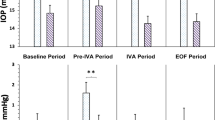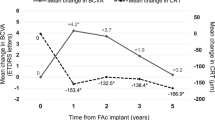Abstract
Purpose
To report two cases of young diabetic patients with intractable neovascular glaucoma (NVG) who were successfully managed with bevacizumab and mitomycin C-augmented trabeculectomy.
Results
Two young patients present with severe NVG secondary to diabetic proliferative retinopathy. The glaucoma was unresponsive to conventional medical therapy and complete panretinal photocoagulation. Both patients underwent augmented trabeculectomy with MMC and intravitreal injection of bevacizumab. Iris rubeosis resolved within 48 h. Both patients have a follow-up period of 6 months and the intraocular pressure (IOP) remain between 10–15 mmHg.
Conclusions
Controlling IOP due to NVG in young diabetic patients is difficult and augmented trabeculectomy has a very high failure rate. The addition of intravitreal bevacizumab in the management of NVG particularly in young diabetic patients may improve the success rate of IOP control. It is known that bevacizumab retards neovascularisation. It may also be modulating wound-healing response as well. Bevacizumab may have a potential role in the surgical management of NVG.
Similar content being viewed by others
Introduction
Neovascular glaucoma (NVG) in young diabetic patients carries a bad prognosis and satisfactory control of intraocular pressure (IOP) is often very difficult to achieve even with augmented trabeculectomy.1 IOP control with tubes and cyclodestructive procedures are unpredictable and long-term hypotony is not uncommon.
We report two young insulin-dependent diabetic patients who developed NVG and were treated successfully with intravitreal bevacizumab and MMC-augmented trabeculectomy.
Case 1
A 20-year old insulin-dependant diabetic of 18 years’ duration presented with bilateral extensive proliferative retinopathy and a high IOP of 56 mmHg in the left eye. IOP in the right eye was 18 mmHg. Visual acuity was 6/9 on the right and 6/18 on the left. Both eyes received panretinal photocoagulation totalling more than 3000 burns to each eye. Topical latanoprost, timolol maleate, and brimonidine failed to control IOP, which remained at 50 mmHg. Gonioscopy revealed open angles with neovascularisation. The left eye developed vitreous haemorrhage requiring pars plana vitrectomy and further endolaser treatment. Lensectomy was not performed. A retinal break was noticed intraoperatively, which was treated with cryotherapy. At the time of vitrectomy, bevacizumab 0.1 ml/1.25 mg was injected intravitreally. This had a dramatic effect on inducing regression of the iris rubeotic vessels. On maximal antiglaucoma treatment, her left IOP was 18 mmHg.
She was re-presented two months later with a left IOP of 42 mmHg. Rubeosis iridis was again florid and there was retinal neovascularisation in both eyes. Gonioscopy revealed peripheral anterior synechaie with synechial angle closure. She had left trabeculectomy with mitomycin C (0.2 mg/ml for 2 min subconjunctivally) and intravitreal injection of bevacizumab (0.1 ml/1.25 mg). Antiglaucoma treatment was stopped. Up to 7 months postoperatively, the IOP remained under control (between 10 and 15 mmHg) with the need for no antiglaucoma treatment and visual acuity was stable at 6/36.
Case 2
A 29-year old insulin-dependant diabetic presented with a painful left eye, and an IOP of 46 mmHg, with rubeosis iridis, and counting fingers vision. Gonioscopy revealed florid peripheral anterior synechiae with angle closure. She had undergone a left pars plana vitrectomy, delamination, and endolaser for proliferative diabetic retinopathy and tractional retinal detachment a month before the presentation. She was started on timolol maleate, apraclonidine, and latanoprost but IOP was still not controlled, so an MMC-augmented trabeculectomy (0.2 mg/ml subconjunctivally) with intravitreal bevacizumab (0.1 ml/1.25 mg) was performed 10 days after the vitrectomy. Postoperatively, she was kept off antiglaucoma medication. To date, after 6 months follow-up, the patient has a functioning bleb with stable IOP, between 9 and 14 mmHg, and a vision of 6/36 unaided.
Discussion
Achieving adequate control of IOP that is associated with iris neovascularisation is difficult, especially, if there is development of angle closure and obliteration of the angle. Neovascularisation is due to retinal ischaemia and hypoxia, which results in release of angiogenic factors such as vascular endothelial growth factor (VEGF) and fibroblast growth factor (FGF). Rubeosis can be severe, if there is a breach in the anterior hyaloid surface (as in vitrectomy) and the posterior capsule. The options to control the IOP are very limited. While conventional trabeculectomy invariably fails to control NVG,2 augmentation with mitomycin C or 5-fluorouracil has a low success rate.1 Another management option is the use of cyclodestructive procedures, but the results are unpredictable and development of hypotony is a common complication.3 This problem is particularly intense in young patients.4
The two patients we managed had a multitude of negative prognostic factors such as young age, active retinal neovascularisation secondary to diabetes, and rubeosis iridis. Additionally, they both had previous vitrectomy, which possibly contributes to increased neovascularisation, and a retinal break and detachment. Augmented trabeculectomy combined with panretinal photocoagulation is ineffective in patients with proliferative membranes and retinal detachments.5 In these patients, successful filtration surgery requires control of the neovascular process and modulation of healing response at the trabeculectomy site. The same growth factors that enhance neovascularisation also encourage wound healing at the trabeculectomy site.6, 7
Maximum panretinal photocoagulation failed to control the proliferative changes. Intravitreal bevacizumab has been shown to induce regression of new blood vessels in patients with proliferative vitreoretinopathies.8 This can facilitate a successful trabeculectomy in NVG patients. However, this effect is short-lived and studies have only shown intravitreal bevacizumab as being successful up to 6 weeks.9, 10 We believe that short acting intravitreal bevacizumab alone may not be sufficient to control the IOP in high-risk NVG patients and healing response at the trabeculectomy site may need to be modulated. Mitomycin C is a well-established agent to augment trabeculectomy, especially in high-risk patients, by downregulating the healing response at the trabeculectomy site and prevent fibrosis and failure of the bleb. However, MMC-augmented trabeculectomy in NVG has a high failure rate. Bevacizumab, although being an anti-VEGF agent, also has modulatory effect on fibroblast proliferation, and thus wound healing. Laboratory studies have shown that human corneal fibroblasts exhibited significant morphological changes when treated with bevacizumab in the form of loss of cell–cell interaction and adhesion properties.11 Bevacizumab has also been shown to cause impaired wound healing and wound dehiscence, when used systemically in management of colorectal carcinoma.12, 13 The use of bevacizumab to control NVG due to a variety of causes are beginning to emerge in the recent literature.8, 14, 15, 16, 17 Only a very few have used bevacizumab to treat NVG secondary to proliferative retinopathy and these have reported short-term success.15, 17 Our two patients are unique as the NVG has reached the angle closure stage. Further, we have achieved successful control of IOP for long term. We believe that the bevacizumab has potentially contributed to the successful control of IOP by modulating the healing response at the trabeculectomy site along with mitomycin C. In both our cases, IOP is still controlled after more than 6 months, despite the poor prognosis at the outset. The combined application of intravitreal bevacizumab and mitomycin C-modulated trabeculectomy may be an alternative option in the management of high-risk NVG (Figures 1, 2 and 3).
References
Sisto D, Vetrugno M, Trabucco T, Cantatore F, Ruggeri G, Sborgia C . The role of antimetabolites in filtration surgery for neovascular glaucoma: intermediate-term follow-up. Acta Ophthalmol Scand 2007; 85 (3): 267–271.
Mietz H, Raschka B, Krieglstein GK . Risk factors for failures of trabeculectomies performed without antimetabolites. Br J Ophthalmol 1999; 83 (7): 814–821.
Salim S, Scott I, Fekrat S . Diagnosis and treatment of neovascular glaucoma. EyeNet 2001; 5 (7): 35–37.
Sturmer J, Broadway DC, Hitchings RA . Young patient trabeculectomy. Assessment of risk factors for failure. Ophthalmology 1993; 100 (6): 928–939.
Kiuchi Y, Sugimoto R, Nakae K, Saito Y, Ito S . Trabeculectomy with mitomycin C for treatment of neovascular glaucoma in diabetic patients. Ophthalmologica 2006; 220 (6): 383–388.
Nissen N, Polverini PJ, Koch AE . Vascular Endothelial Growth Factor mediates angiogenic activity during the proliferative phase of wound healing. Am J Pathol 1998; 152 (6): 1445–1452.
Stadelmann W, Digenis A, Tobin G . Physiology and healing dynamics of chronic cutaneous wounds. Am J Surg 1998; 176 (Supp 2A): 26S–38S.
Arevalo J, Wu L, Sanchez J, Maia M, Saravia M, Fernandez C et al. Intravitreal bevacizumab for proliferative diabetic retinopathy: 6-months follow-up. Eye 2007, advance online publication September 2007; doi:10.1038/sj.eye.6702980. http://www.nature.com/eye/journal/vaop/ncurrent/pdf/6702980.pdf.
Kelkar AS, Kelkar SB, Kelkar JA, Nagpal M, Patil SP . The use of intravitreal bevacizumab in neovascular glaucoma: a case report. Bull Soc Belge Ophthalmol 2007; 303: 43–45.
Gheith ME, Siam GA, de Barros DS, Garg SJ, Moster MR . Role of intravitreal bevacizumab in neovascular glaucoma. J Ocul Pharmacol Ther 2007; 23 (5): 487–491.
Afshari N . Research in cornea and external disease in refining current concept and branching out into new avenues of investigation. Rev Ophthalmol Online April 2006, vol. 5, Number 13. http://www.revophth.com/index.asp?page1_943.htm.
Hurwitz H, Saini S . Bevacizumab in the treatment of metastatic colorectal cancer: safety profile and management of adverse events. Semin Oncol 2006; 33 (5 Suppl 10): S26–S34.
Scappaticci FA, Fehrenbacher L, Cartwright T . Surgical wound healing complications in metastatic colorectal cancer patients treated with bevacizumab. J Surg Oncol 2005; 91: 173–180.
Ichhpujani P, Ramasubramanian A, Kaushik S, Pandav SS . Bevacizumab in glaucoma: a review. Can J Ophthalmol 2007; 42 (6): 812–815.
Grisanti S, Biester S, Peters S, Tatar O, Ziemssen F, Bartz-Schmidt KU . Intracameral bevacizumab for iris rubeosis. Am J Ophthalmol 2006; 142 (1): 158–160.
Iliev ME, Domig D, Wolf-Schnurrbursch U, Wolf S, Sarra GM . Intravitreal bevacizumab (Avastin) in the treatment of neovascular glaucoma. Am J Ophthalmol 2006; 142 (6): 1054–1056.
Mason III JO, Nixon PA, White MF . Intravitreal injection of bevacizumab (Avastin) as adjunctive treatment of proliferative diabetic retinopathy. Am J Ophthalmol 2006; 142 (4): 685–688.
Author information
Authors and Affiliations
Corresponding author
Rights and permissions
About this article
Cite this article
Cornish, K., Ramamurthi, S., Saidkasimova, S. et al. Intravitreal bevacizumab and augmented trabeculectomy for neovascular glaucoma in young diabetic patients. Eye 23, 979–981 (2009). https://doi.org/10.1038/eye.2008.113
Received:
Revised:
Accepted:
Published:
Issue Date:
DOI: https://doi.org/10.1038/eye.2008.113
Keywords
This article is cited by
-
The control of conjunctival fibrosis as a paradigm for the prevention of ocular fibrosis-related blindness. “Fibrosis has many friends”
Eye (2020)
-
A Prospective Study to Evaluate Intravitreous Ranibizumab as Adjunctive Treatment for Trabeculectomy in Neovascular Glaucoma
Ophthalmology and Therapy (2015)






